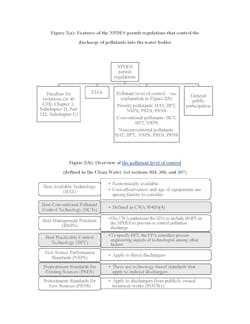NPDES Permits: A Strategy to Mitigate PFAS in Water
In April 2022, the EPA announced three new actions indicating progress on the PFAS Strategic Roadmap. One of these actions was on the EPA’s use of the National Primary Discharge Elimination Service permits (NPDES permits) to restrict the discharge of PFAS into water bodies. This memo and its anticipated implications on mitigating the PFAS levels in water will be discussed in this article following a description on the basics of the NPDES permits.
Basics of the NPDES Permits
Facilities or operators require NPDES permits when discharging specified pollutants from specific point sources into particular types of water in the United States, listed in Figure 1. The EPA’s website on NPDES also discusses this list and also provides information about the basics of the NPDES permits including who needs the permit and where to apply for it.
Figure 1 mentions that not all states have the full authority to issue NPDES permits. The map on the EPA’s website shows that while the majority of the states have full authority to issue the NPDES permits and some of these states also include approved biosolid programs, there are a few states that have partial authority, and even fewer states that do not have the authority to issue NPDES permits.
For unauthorized states, the EPA’s website mentions to contact the EPA regional offices regarding the NPDES permits. According to this website, there is no fee for the NPDES application or for obtaining coverage under the NPDES. However, there might be state fees for the application and the notice of intent (NOI) for the general permit.
The Two Types of NPDES permits
The general permit is one of the two NPDES permit types, the other is the individual permit. The permittee, coverage conditions in the permits, the duration to obtain the permit, and the permit application process are different for these two types of permits, summarized in Table 1. The section on the NPDES Technical Resources contains the NPDES permit writer’s manual, trainings, forms, and also the electronic Notice Of Intent (NOI).
Notice Of Intent (NOI)
The NOI is a notice of the operator’s intent for using the NPDES general permit. Specifically, it includes information about the planned discharge. As mentioned in Table 1, it is submitted by the operator after the general permit is issued by the permitting authority. However some of the general permits such as the EPA’s pesticide general permit do not require an NOI.
NPDES permit regulations
All permittees, even those that do not require an NOI, must comply with the requirements in their permits.
Created in 1972 by the Clean Water Act (CWA), the NPDES regulations are in the Code of Federal Regulations (CFR) Title 40 Chapter 1, subchapter D, in Parts 122 to 125 and 127. The content for these parts are summarized in Table 2.
In addition to providing definitions in the subsections, these parts also contain comprehensive information on important aspects of the NPDES permit program ranging from who needs to apply for the permit, the data required by the permittee for reporting to the EPA, and the frequency of the reporting. They also cover permit requirements for different facilities including for animal feed operations and regulated small municipal separate storm sewer systems (known as MS4).
Sampling and inspection: The NPDES permit requires the discharge facility (the permittee) to sample its discharge at the specified frequencies and to notify the results of this sampling and any non-compliance issues to the applicable state regulatory agencies and to the EPA. Additionally, the state regulatory agencies or the EPA may send inspectors to the discharge facility to check on its compliance with its NPDES permit.
The NPDES permit also contains language on best practices and management, and it also specifies the acceptable level of pollutants (also known as the effluent limit guidelines, ELGs). Language in 40 CFR regarding the NPDES specifies the penalties for violating the NPDES permit. The use of these three features, also mentioned in Figure 2, for enforcing permit conditions are further described here.
- Penalties for violations: include fines or revocation of the permit depending on the violation.
- Effluent Guideline Limits (ELGs): ELGs are regulations developed by the EPA and incorporated into permits for direct and indirect dischargers who discharge point source pollutants into the water of the United States and into a publicly-owned treatment works (such as into a municipal sewage treatment plant), respectively. ELGS are developed based on the cost and effectiveness of the pollution control technologies. The EPA also revises existing ELGs and the following factors are considered for prioritizing the revisions: the type and concentration of pollutants in the discharge, the performance and cost of the applicable technologies for reducing the concentration of the pollutants, and the opportunity to promote technological improvements or innovations for the applicable technologies. For example, the EPA announced in the 2021 Preliminary Plan 15 that it planned on revising existing ELGs for selected types of facilities that were identified as significant sources of PFAS discharge in industrial wastewater. These were PFAS-manufacturing facilities and those that used PFAS to produce other products.
- The pollutant level of control: This is done by applying different practices listed in Figure 2b to three types of pollutants – priority, conventional, and nonconventional pollutants.
- The opportunity for the public to participate in the permit-review process: In addition to the opportunity to be involved in the ELG planning process, the general public can use the following websites to review monitoring reports on discharge facilities that hold NPDES permits:
- Enforcement and Compliance History Online (ECHO)
- How’s my waterway, version 2 This is another website providing, in addition to information for NPDES permittees, the conditions of the watersheds.
EPA's April 2022 NPDES Memo
Leverage on the NPDES permitting to reduce the levels of PFAS in the environment is one of the tasks included in the PFAS Strategic Roadmap announced in 2021. Undertaken by the EPA’s Office of Research, action on this task is expected in Winter of 2022. This memo was the latest progress pertaining to the NPDES permits for PFAS regulations. It contained three actions:
- The first draft aquatic life criteria for PFOA (perfluorooctanoic acid) and PFOS (perfuorooctanesulfonic acid), the two most prominently studies PFAS chemicals by the federal and state agencies.
- The use of the NPDES program by the EPA to restrict the discharge of PFAS into water bodies.
- Announcement on the draft EPA method for screening chemicals including PFAS.
Mitigating PFAS Discharge Into Water Bodies
All of the above three actions in the April 2022 memo assist in minimizing the discharge of PFAS in water. Following this, the EPA also released memos in May and June 2022. This section highlights the specific elements of these actions in this regard.
April 2022 Memo
Draft Aquatic Life Criteria for PFOA and PFOS
This memo proposed the first aquatic life criteria for PFOA and PFOS, which included:
- Draft freshwater acute water column-based criterion magnitude: 49 mg/L for PFOA, 3 mg/L for PFOS
- Draft chronic water column-based chronic criterion magnitude: 0.094 mg/L for PFOA, 0.0084 mg/L for PFOS
- Draft chronic freshwater tissue-based criterion magnitude: 6.10 mg/kg wet weight for fish whole body for PFOA. This value is 6.75 mg/kg for PFOS. For fish muscle tissue, this value is 1.11 mg/kg wet weight for PFOA and 2.91 mg/kg wet weight for PFOS.
As these are still draft values, they are open for public comments until July 2022. These values reflect the latest scientific knowledge about the effects of PFOA and PFOS on freshwater organisms. Although they do not pertain directly to the NPDES permits, they show that PFAS, even in small quantities, can have chronic effects on freshwater organisms.
Restricting the discharge of PFAS
The April 2022 memo by the EPA will assist the EPA to carry out the central directive on “Restrict” in the PFAS Strategic Roadmap. The EPA plans to use its authority under the CWA to carry out this goal.
Use of Draft Methods 1633
EPA-issued permits to the applicable industrial direct dischargers should include effluent monitoring for each of the 40 PFAS parameters using draft method 1633 (while final methods are unavailable) at least every four months to ensure adequate data to monitor for the PFAS in the discharge.
For permits issued to the publicly owned treatment works (POTWs) by the EPA and where the EPA has the authority for pretreatment control, the draft method 1633 should be used for monitoring PFAS in the influent and biosolids in addition to for effluents. This method can be used with method 1621 (for measuring adsorbable organic fluorine), when appropriate.
Best Management Practices (BMPs): Permittees should use BMPs including substituting PFAS for other chemicals and eliminating it in the discharge. BMPS should be included for stormwater permits to eliminate PFAS in aqueous film forming foam (AFFF) and immediate cleanup where AFFFs have been used.
The quantity of pollutants contributed by the industry users (UI) (the permit holders) to the POTW should be included as part of the UI inventory and provided to the EPA treatment control authority within a year. UI BMPS or local discharge limits should be developed (when authority exists) and in the absence of local limits, the regional pretreatment coordinators should work with the POTWs on ways to reduce PFAS discharge to POTWs.
Other Mitigation Strategies
Public notification: The April 2022 memo also requires notifying people who might potentially be affected by the NPDES discharge while the pertaining permits are in the draft stage. EPA permit writes for draft permits are also encouraged to collaborate with applicable drinking water programs to determine which public water systems should be notified.
The May and June 2022 memos
In the May 2022 memo, the EPA announced the risk-based values for seven PFAS. These values are specifically known as the regional screening and remedial management levels for the purpose of site cleanup. Two memos were released to the public in June 2022 – on the national testing strategy that included 6:2 fluorotelomer sulfonamide betaine (a type of PFAS) and four drinking water Health Advisories, specifically revised values for PFOA and PFOs and final values for perfluorobutane sulfonic acid (PFBS) and hexafluoropropylene oxide (HFPO) and their salts. While these memos do not pertain directly to the NPDES permits, they supply information to the foundation on the need to restrict PFAS discharge into water.
The Road Forward
The draft aquatic life criteria values, the EPA’s draft methods 1621 and 1633 for screening PFAS and AOF in the EPA’s April 2022 memo and the announcement on the risk-based values for seven PFAS as well as the revised Health Advisories in the recent memos show progress made directly and indirectly for restricting the discharge of PFAS into water bodies.
Additionally, the enforcement features of the NPDES permits (penalties, ELGs, pollutant level for control) shows optimism for this restriction. However, the use of the NPDES permits to restrict PFAS discharge into water bodies should go hand in hand with remedial technologies to remove PFAS from the water to protect public and environmental health. PFAS are recalcitrant in the environment and to clean up PFA-contaminated areas, remedial technologies are required.
In addition to the NPDES permits, RCRA permits (in 40 CFR Part 124) should also be addressed to restrict PFAS discharge into the environment. It is also important to encourage public participation in the NPDES permitting decisions. According to the EPA, the public is allowed to comment on the permit applications for both EPA-authorized and state-authorized NPDES permits. Public participation will assist in enforcing permit conditions to restrict PFAS discharge into the water.
About the Author
Saleha Kuzniewski
Saleha Kuzniewski, Ph.D. has authored several publications in the fields of scientific research, biotechnology, and environmental regulations. She is the winner of the 2023 Apex award for publication excellence. She is also the founder of Environmental Remediation & Innovations, LLC. Kuzniewski can be reached at [email protected].



